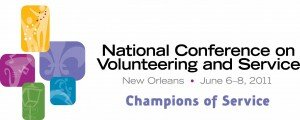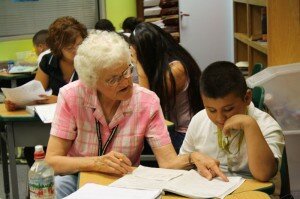This year’s National AmeriCorps Week, May 14 – 21, is a particularly important opportunity to elevate the value and importance of AmeriCorps and national service. In light of recent budget debates in Congress and the threatened elimination of funds for the Corporation for National and Community Service (CNCS) in 2012, AmeriCorps Week showcases the extraordinary impact of national service members every day across our nation.
 AmeriCorps Week shines a light on the more than 80,000 members currently serving in communities across the country – individuals who are effectively serving and meeting critical needs in our country’s communities. We see this impact front and center in our HandsOn Network where, over the last 12 months, HandsOn Networks’ AmeriCorps members have recruited and mobilized more than 53,900 volunteers in more than 1,200 service projects impacting more than 70,000 citizens.
AmeriCorps Week shines a light on the more than 80,000 members currently serving in communities across the country – individuals who are effectively serving and meeting critical needs in our country’s communities. We see this impact front and center in our HandsOn Network where, over the last 12 months, HandsOn Networks’ AmeriCorps members have recruited and mobilized more than 53,900 volunteers in more than 1,200 service projects impacting more than 70,000 citizens.
In addition to 80,000 current members, more than 600,000 have joined AmeriCorps Alums, a division of Points of Light Institute, and have given more than 860 million hours in service since 1994.
We believe in the leadership potential of these individuals and have supported them both as an organization and a strategy to continue to create change. We have 26 chapters of AmeriCorps Alums throughout the country actively engaging thousands during AmeriCorps Week in service projects, networking events and thought leadership with elected officials.
The value of AmeriCorps service has been felt in communities both large and small – at Points of Light Institute affiliates, managing volunteers in disaster relief efforts and at the countless organizations that we partner with.
Philadelphia Mayor Michael Nutter has said he believes the future of his city depends on citizens rolling up their sleeves and working together to tackle complicated challenges – and AmeriCorps Alums have played a major role.
“AmeriCorps Alums working in city government and nonprofit organizations throughout Philadelphia bring a level of experience and commitment to service that directly impacts our collective capacity to engage every day citizens in solving problems and strengthening their communities,” said Mayor Nutter.
The National League of Cities highlighted the impact of AmeriCorps volunteers in an editorial by AmeriCorps Alums Executive Director Ben Duda this week. The article reaches 30,000 mayors, city council members, city managers, police and fire chiefs, public works directors and others who make decisions about local operations. It is important that these individuals understand the valuable impact of service and how they can engage both current AmeriCorps members and AmeriCorps Alums to address local challenges and create change.
To share best practices, AmeriCorps Alums has convened a national training and professional development webinar called “How to Translate Your AmeriCorps Experience into Future Leadership Opportunities” on May 18 at 12 p.m. EST. This session will showcase the transformational force of service and how it can make an impact in solving our country’s challenging issues.
To register for the webinar or get engaged with your local AmeriCorps Alums, please visit www.AmeriCorpsAlums.org.
National service has a critical role to play in our country as we face tough challenges and restricted funds. At Points of Light Institute, we look forward to celebrating AmeriCorps Week with our service partners and colleagues and lifting up currently serving members and the hundreds of thousands of Alums – they are at the forefront of possibility for community change.
Yours in Service,


 In case any of you hadn’t heard, Jer Clifton was the man who pulled a man to safety after he had fallen onto the train tracks in the Atlanta Subway. You can see his efforts
In case any of you hadn’t heard, Jer Clifton was the man who pulled a man to safety after he had fallen onto the train tracks in the Atlanta Subway. You can see his efforts 

 Blogging
Blogging Foursquare
Foursquare YouTube
YouTube
 The Road to the Gulf is series of projects that helped to move the work and service from the 2010
The Road to the Gulf is series of projects that helped to move the work and service from the 2010  With
With  Greater DC Cares‘ Road to the Gulf project was part of their largest day of service during the year. It was one of over 150 service projects that worked to build a stronger DC. Their Road to the Gulf project focused on supporting Living Wages, which helps to build stronger citizens that are involved in their community.
Greater DC Cares‘ Road to the Gulf project was part of their largest day of service during the year. It was one of over 150 service projects that worked to build a stronger DC. Their Road to the Gulf project focused on supporting Living Wages, which helps to build stronger citizens that are involved in their community. This special 3-hour workshop at the
This special 3-hour workshop at the 

 Looking at the impact of volunteers highlights the individual, institutional, and community change that volunteers can bring about through their service. Sessions in the impact track focus on specific solutions that volunteers can bring to
Looking at the impact of volunteers highlights the individual, institutional, and community change that volunteers can bring about through their service. Sessions in the impact track focus on specific solutions that volunteers can bring to  Boomers and
Boomers and 
 Today’s post comes from Yuan YanBin, and Intern with
Today’s post comes from Yuan YanBin, and Intern with  Considering that the people in this elderly center are Shanghainese, the volunteers first played Zhou Libo’s (a Shanghai stand-up comedian) famous shtick video for them to watch, which resulted in bursts of laughter. Then the volunteers sang two old songs to remind them of their youth days, which they happily sang along to. They also read famous poems from the 1950s that described the conditions of the time and reminded them of that glorious time in the past.
Considering that the people in this elderly center are Shanghainese, the volunteers first played Zhou Libo’s (a Shanghai stand-up comedian) famous shtick video for them to watch, which resulted in bursts of laughter. Then the volunteers sang two old songs to remind them of their youth days, which they happily sang along to. They also read famous poems from the 1950s that described the conditions of the time and reminded them of that glorious time in the past. Moreover, the students taught them the Finger Exercises, encouraging them to take care of themselves, do more exercises, and have a healthier life.
Moreover, the students taught them the Finger Exercises, encouraging them to take care of themselves, do more exercises, and have a healthier life. In the end, volunteers had to say goodbye to the elderly. During this short period of one hour, the volunteers filled the elderly lives with color and joy, and made their lives at HPECC more fun. With the day’s activities, the volunteers gained a sense of belonging and spent a meaningful day with the elderly that kept a smile on all of their faces for the rest of the day. This was not the first time that volunteers from SU visited the HPECC and brought laughter and happiness to their lives and it will certainly not be their last!
In the end, volunteers had to say goodbye to the elderly. During this short period of one hour, the volunteers filled the elderly lives with color and joy, and made their lives at HPECC more fun. With the day’s activities, the volunteers gained a sense of belonging and spent a meaningful day with the elderly that kept a smile on all of their faces for the rest of the day. This was not the first time that volunteers from SU visited the HPECC and brought laughter and happiness to their lives and it will certainly not be their last!
